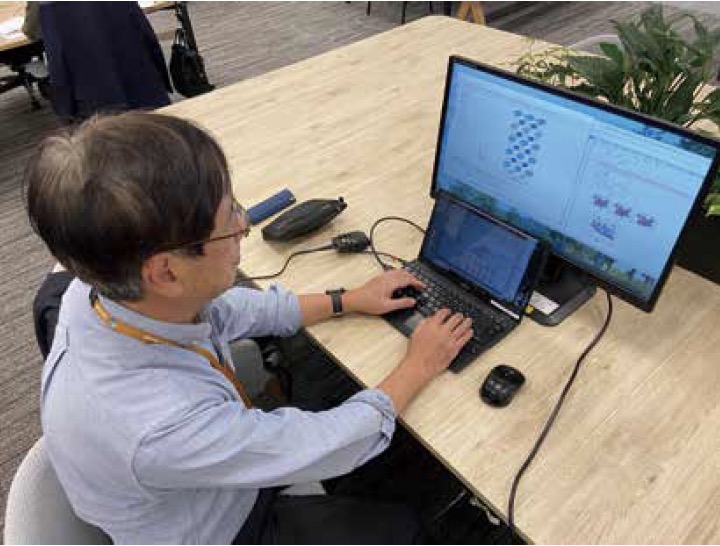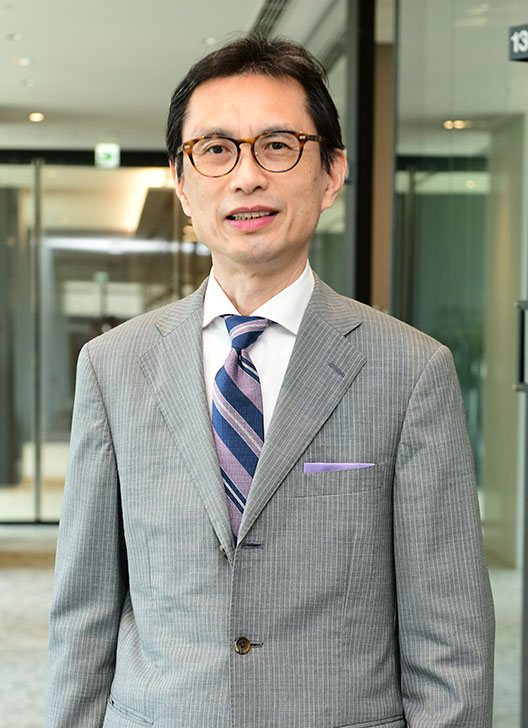
Since 2017, the JX Nippon Mining & Metals Group has been promoting the IoT 5+1 Year Plan with the aim of establishing a business foundation to realize our ideal state of being a technology-based company, as envisioned in our 2040 Long-Term Vision. We are working to utilize IoT and AI to improve productivity and quality, evolve preventive maintenance, improve safety, and reduce environmental impact in all areas of our business.
The JX Nippon Mining & Metals Group Long-Term Vision 2040
Nonferrous metal materials, comprising core products for the Group, require constant creation and innovation in response to changes in society, industry, and technology. The Group must keep up with the pace of these changes and continue to innovate its own processes. To do so, it is essential to introduce and implement cutting-edge digital technology, and we must execute our plans by closely sharing awareness of the issues at hand with people in the field, who are the primary drivers of innovation.
In the IoT 5+1 Year Plan, the Technology Group has been established as the controlling organization, and the IoT Subcommittee established within each division leads measures, with the IT Department’s Digital Innovation team serving as the promotion secretariat and providing technical support. Each measure was to automate processes (reductions in costs, lead-times, etc.) by introducing IoT and AI technologies, and to digitize analog information (paper documents, forms, etc.) regarding processes, and to stock this information across all businesses. In doing so, we have also been working on new technologies in the pre-practical stage in verification tests. In addition, we are also engaged in verification tests of highly promising elemental technologies, such as technology for optimization calculations using quantum annealing computers, and topographical change and landslide monitoring using satellite-based SAR survey technology.

The measures promoted under the IoT 5+1 Year Plan have resulted in approximately 120 demonstration tests. Several of these have been converted to practical application and we are currently establishing databases in related departments. In fiscal 2021, we began formulating the IoT/AI Six-Year Plan (2023 - 2028) to further deepen and accelerate DX.
In this plan, new issues have been identified in light of changes in the business environment, and its new measures include attempting to utilize collected data as feedback in manufacturing processes, solving issues in sales and logistics domains, and introducing IoT technology for the purpose of decarbonization. In addition, we aim to promote DX throughout the supply chain to create value for our customers and more proactively utilize digital technology to address the issues of securing and training human resources and addressing work styles.

Click to enlarge
Activities that had been conducted by subcommittees have been restructured for total optimization. In the six years through 2028, we will develop an infrastructure base for data integration using the new network, and will also utilize the digital twin model, leading to a new value chain.
At the Caserones Copper Mine in Chile, we are engaged in a wide range of initiatives to introduce advanced technologies, with a focus on IoT. This includes condition monitoring for mining heavy equipment and ore filtering-related equipment (data collection and reporting), early detection of problems by installing cameras, and evolving machinery operation control.
By building a system that makes use of the ideas of the highly-talented staff on the Chilean side, and by ensuring strong teamwork with engineers seconded from Japan, we aim to further improve the performance of the copper concentrates processing plant and further stabilize operations. We are also working to adopt and roll out these success stories to other sites, such as the Saganoseki Smelter & Refinery.


Copper concentrates processing plant at the Caserones Copper Mine
The JX Nippon Mining & Metals Group aims to establish hybrid smelting technology that significantly increases the ratio of recycled raw materials by leveraging its accumulated strengths in material recycling technologies. In order to cope with the increase in the amount of recycled raw materials collected, we are improving the efficiency and strengthening the management of the series of processes from raw material procurement to operation. By establishing a system that aggregates data on raw materials and each process and provides feedback with the necessary information, we will pursue total optimization and improve productivity by collecting raw materials in a timely manner and improving the accuracy of production forecasts. Furthermore, in order to realize our Sustainable Copper Vision, we will continue to strive toward the percentage of recycled raw materials (input ratio of raw materials or content ratio in products) to 50% or more by 2040.

Saganoseki Smelter & Refinery (Oita Prefecture)

A converter furnace at the Saganoseki Smelter & Refinery
We are working to automate production processes for advanced materials at the Nasu Works through the use of image processing technology. In the inspection process of micro-connectors and other precision components, defective products are sorted and identified in detail based on multiple images. Since it is important to capture images that enable precise and stable identification of the subject during image analysis, we conducted a series of tests of the image capture environment and methods by installing numerous cameras at various positions and angles in the actual process.
For one product (an electronic component about 1.5 mm long), we developed a device that can capture 34 close-up images with 10 cameras for each item. The resulting images are processed to determine whether the item passes inspection or not. This enables mid-process determination and removal of defects such as surface chipping and irregularities that could not be detected until visual inspection in the final process. In addition to reducing manpower and increasing efficiency in inspections, feedback on defective products has become faster, and process improvements have not only reduced the defect rate itself, but are also being used to analyze defect factors that were previously unknown.


Production line at Nasu Works
In the process of manufacturing semi-finished sputtering targets from raw powder, the relationship between raw powder conditions and the occurrence of defects is analyzed and provided as feedback to the manufacturing department to reduce the defect rate. In the process of shaping semi-finished sputtering targets, pressure is applied to these semi-finished products. Traditionally, these semi-finished products weighing several tens of kilograms had to be manually set on the shaping equipment, a task that was extremely burdensome for operators. Therefore, by using image analysis to determine the shape of deformed semi-finished products, we calculated the appropriate processing method and combined this with an arm robot to automate the setting process. This not only reduced operator workload and improved work safety, but also enabled unmanned operation, contributing to increased productivity.

Automated inspection system utilizing an arm robot
Our R&D units use molecular simulation software, a cutting-edge deep learning technology that accelerates quantum chemical calculations, as well as materials informatics technology to explore new materials in the areas of copper alloys, ceramics solid-electrolytes, and more. The simulation team conducts interviews with the Material Development Group and customizes algorithms for each material topic to aid in research and prediction of new materials.

A simulation in progress
The JX Nippon Mining & Metals Group will actively incorporate cutting-edge real-time simulation technologies and artificial intelligence methods to utilize a variety of simulations not only in material exploration, but also in design and manufacturing processes. By doing so, we aim to build a digital twin infrastructure that can be applied from R&D to manufacturing, sales, and even to the customer’s premises in the future.
In response to changes in work styles amid the COVID-19 pandemic and requests from business partners to strengthen security measures, the Group has been upgrading its own network based on the concept of zero trust. This is the most advanced cloud-based security service available today, enabling security management at the terminal and user level that cannot be achieved with conventional perimeter security networks, thereby raising the security level of the entire Group in a uniform manner. This system is already in operation at JX Nippon Mining & Metals’ Head Office and operating sites, and will be rolled out to Group companies in Japan and overseas in stages.

Beginning in fiscal 2019, we have been working to enhance our digital resources and strengthen their training. In data scientist education, we have expanded our training programs according to the level of each employee, such as beginner programs for young employees and intermediate programs for mid-career employees. We also launched follow-up education via e-learning in fiscal 2021, and plan to start literacy education for all employees in fiscal 2022.
We are also working to improve the level of our DX education by strengthening cooperation with educational institutions, such as joint research with Tohoku University and dispatching employees to the Shiga University Graduate School of Data Science.
The Group regards patent information as big data useful for understanding technological trends, and utilizes it not only for the purpose of preventing infringement and determining patentability, but also for various other purposes. For example, by combining IP information from our Group and others with business and market information, we conduct research and analysis (IP landscape) to anticipate changes in customer needs and technology trends, and contribute to the creation of development themes and the search for partners. In fiscal 2021, we held workshops to promote internal IP landscape activities, creating a mock IP landscape with IP and marketing personnel.

A workshop in progress

* Drafted by JX Nippon Mining & Metals based on data from the Biz Cruncher® website by Patent Result Co., Ltd.

JX Nippon Mining & Metals Corporation
Executive Officer, General Manager, IT Department Technology Group
Senior Executive Engineer, Administration Department
Ebihara Hiroyuki
The reason why our Group was quick to take the helm in promoting DX in all areas throughout the organization was a clear sense of urgency. We believe that, in order to respond to rapid changes in the business environment, it is essential to utilize cutting-edge digital technology, and unless we start working on this at an early stage, even at the risk of failure, it will be impossible to remain a leader in the non-ferrous metals industry.
The members of the subcommittees for each division have played a central role in supporting the introduction of new technologies in close cooperation with field engineers at each plant. However, we believe that the introduction of a system for advancing demonstration tests so that we can actively tackle entirely new technologies has led to significant results. Although some of the 120 demonstration tests conducted over a period of five years, did not result in practical application, I believe that a positive mindset was fostered among field stakeholders toward investigating the causes of these failures and applying their findings in future action. This, I believe, has helped a culture of challenge without fear of failure take root throughout the Group.
In the past, planning has focused on bottom-up, plant-by-plant, individual optimization activities. However, as we have worked to automate and streamline, analog data is being replaced by digital data, and we have been solidifying an infrastructure for aggregating information. In the IoT/AI Six-Year Plan to begin in fiscal 2023, we will think beyond the boundaries between plants and operating sites for each business and develop measures aimed at total optimization, with a primary focus on data utilization throughout the supply chain.
Copper, a mainstay product for the Group, is an indispensable material for promoting DX in society, and we must meet the demands of our customers and the market as a technology-based company. We intend to further accelerate the Group’s DX strategy and quickly establish a rapid technology development system and a highly efficient profit structure.